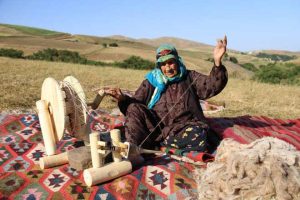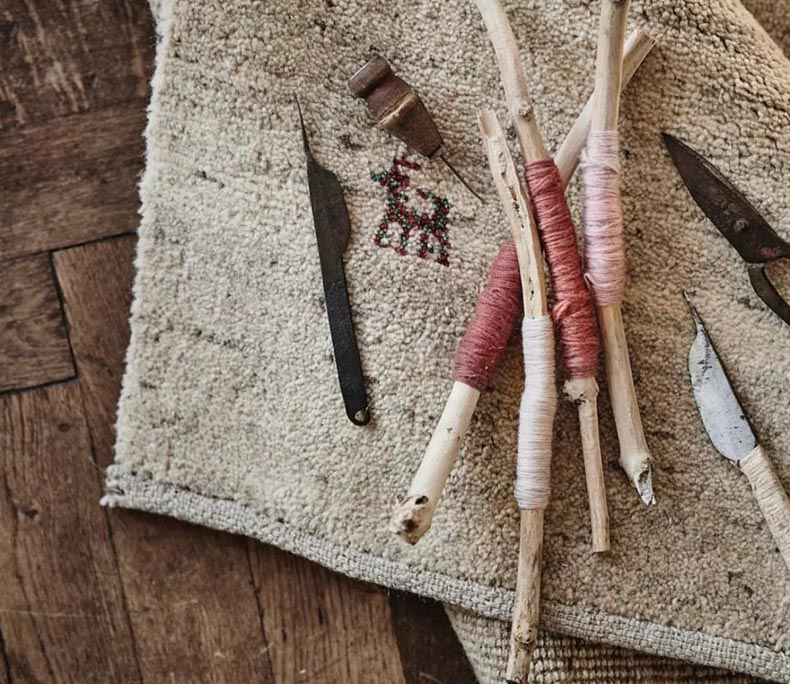Raw materials for handmade carpets
Handwoven carpet is one of the goods that is very important in human life. In addition to doubling the beauty of your living space, hand-woven carpets help a lot in comfort and improving the level of human well-being. One of the most important criteria for determining the quality and value of a handmade carpet is the raw materials used in it. In this article, we try to introduce you to the raw materials that make up carpets so that you can purchase hand-made carpets with more knowledge.
The raw materials for making handmade carpets are:
Wool
Wool is a protein fiber that is harvested from sheep. In Iran, sheep’s wool is of high quality, especially in the areas of Sanandaj, Kerman, Mako, Mughan and Khorasan. The wool of Iranian sheep is more thick, and because of this roughness and thickness, it has more strength and durability and is very suitable for carpet weaving. Sheep that are raised in mountainous areas have better quality than other areas. Wool is usually used as pile of rug , but in nomadic carpets such as Bakhtiari carpets, Qashqai carpets, Baluch carpets, the warps and wefts of carpets are also made of wool.

Sheep
The best type of wool is wool that is picked from live sheep in the spring. The wool of dead sheep that is separated from the skin by chemical treatment is not suitable for carpet production at all. This type of wool always has an unpleasant smell and does not have the transparency of live sheep’s wool and is very short-lived. White wool has a high color absorption property compared to other wools. The wool of some sheep, such as Sistani sheep, is completely white, which gives more effect to dyeing. The rest of white wools, are pea and cream colored wools, which absorb more color than dark wools.
Also read: Dyeing of handwoven carpet and traditional and industrial methods

Beating Wool
There are 5 steps to prepare a rug in carpet weaving, which are: picking the wool, separating them according to color and type, washing, combing and separating the wool and spinning the wool by hand or spinning factories.

Spinning Wool
The wool that is picked from the sheep has substances and impurities that must be removed from the wool before spinning. These substances include the amount of lanolin fat produced by the animal’s skin, sand and dirt left on the animal’s skin, urine and dried sweat on the wool. To remove these impurities, we must first wash the fibers and then dry the wool in a clean place. After this stage, the wool should be spun and then the skeins are ready for dyeing.
Silk
Natural silk is made of protein obtained from silkworm cocoons. Around 2700 BC, silk weaving began in China. Silkworm production in Iran is also done in Gilan, Mazandaran, Khorasan, Kashan, Yazd and Azerbaijan. The steps of silk production are as follows: first, the silkworm wraps a cocoon around itself, when the cocoon grows enough and before the worm turns into a butterfly, it is thrown into 60 degree water and boiled.

Silkworm
The worm inside the cocoon is destroyed and only the cocoons remain. After finding the heads of silk fibers, they are made into strings. Then, during certain steps, these strings are converted into silk thread. A cocoon has a thread length of about 500 to 1300 meters.

Silkworm Cocoons
Silk fibers have much higher strength in the same thickness as wool fibers. Silk is used in the pile and warp of handwoven carpets. Nain carpets, Isfahan carpets , Tabriz carpets and Kashan carpets are among the carpets that use silk for flowers of carpet and to brighten and highlight motifs of carpet. Also, in all-silk carpets of Qom, all parts of the carpet, including warp and weft, are made of natural silk. Silk carpet is one of the carpets that has many fans all over the world. Thin pile, lightness, and great shine are the characteristics of natural silk carpet.
Also read: What are natural carpets?

Spinning Silk

Spining Silk to Thread
Cotton
Cotton is called white gold because of its great importance in the textile industry. These fibers are obtained from native plants of tropical regions such as India, America and Africa and are used in the production of yarn and fabric. For this purpose, its fibers are made into strands so that they are stretched and twisted together. Then they are prepared for use in the carpet and fabric industry.

Cotton Plant
The warp and weft of most Iranian handwoven carpets are made of cotton fibers. The most important advantage of cotton fibers over wool fibers is that moth does not like to eat cotton, and as a result, carpets whose warp and weft are made of cotton, if they are exposed to moth-eating, only the piles will be destroyed and the warp and weft will remain healthy. The carpet restorer carpet can easily re-tie piles that match the design of the carpet. Cotton cannot be used as carpet pile. It has been seen in cases where cotton is polished and used in fake silk carpets.

Cotton Threads for Warp and Weft
Fluff
Fluff is obtained from the growth of goat, camel, rabbit and horse hair. These fibers, like sheep’s wool, are made of protein and are very soft, light weight and highly polished. These features make fluff more expensive than wool. In order to obtain hair, they comb the body of a goat or horse, collect the hairs that are stuck on the comb and mix them together to obtain fluffy yarn.
The volume of these hairs is much smaller than wool and it is more difficult to collect them. Also, since the length of the hairs is short, it takes time to spin them. In general, if we want to compare woolen carpets with fluffy carpets, woolen carpets are more durable, transparent and stronger, and sheep’s wool is more capable and efficient than fluff in carpet weaving.

Combing Fluff
In this article, we have tried to fully describe the fibers that make up the handmade carpet. We hope that by reading this article, you have gained useful information about the handmade carpet. If you also have experience in this regard, please share with us in the comments section.










